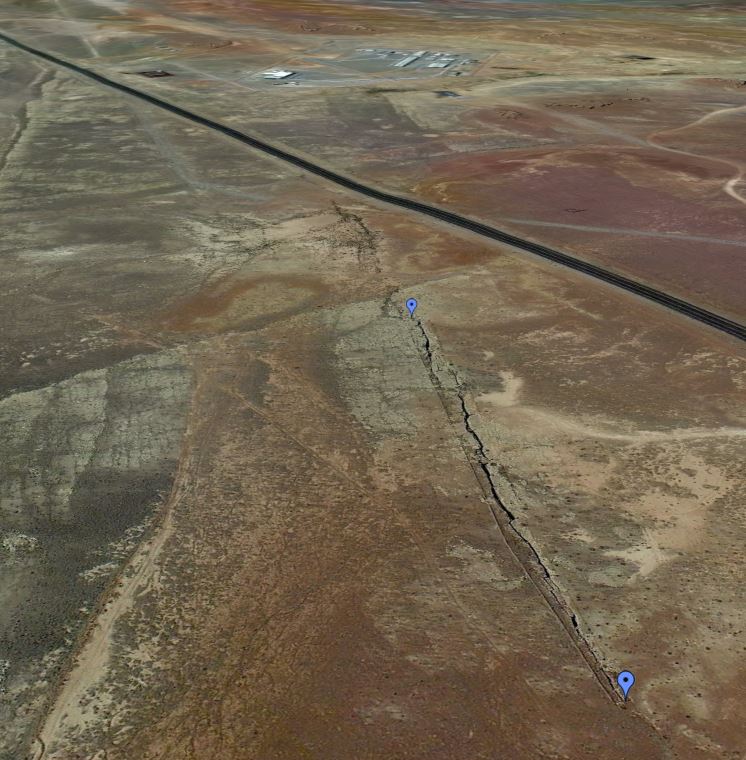ADOT issued the following
news release:
ADOT plans shorter detour for highway closed by landslide south of Page
 Once paved, Navajo tribal road may serve as temporary US 89
Once paved, Navajo tribal road may serve as temporary US 89
PHOENIX — The Arizona Department of Transportation moved one step closer toward establishing a shorter detour route for drivers who travel daily to Page and the Lake Powell area that have been impacted by the landslide closure on US 89. [
Photo credit, ADOT]
At a special meeting of the State Transportation Board today, the board approved $1 million to design improvements to Navajo Route 20, a Navajo Nation tribal road that runs parallel to the damaged highway. Approximately 27 miles of the roadway are unpaved.
“ADOT has been working with the Navajo Division of Transportation, the Navajo Nation and the Bureau of Indian Affairs to pave N20 as an interim measure to shorten the detour route between Flagstaff and Page,” said Dallas Hammit, ADOT deputy state engineer of development. “With assistance from the Federal Highway Administration, we are looking to use federal emergency relief funds to restore essential traffic in the region, while we work on the ultimate repair on US 89.
“This is not the long-term solution, but it will help the thousands of people who are inconvenienced daily by this unscheduled detour caused by last month’s landslide,” Hammit said.
As part of ADOT’s plans to improve the existing 44-mile-long tribal route, which is mostly a dirt road stretching from Bodaway-Gap to LeChee, ADOT would designate the road as Temporary US Route 89 (US 89T).
ADOT would pave the road and ensure that it could carry commercial truck traffic, while repairs are made to US 89. The agency is already working with potential contractors and construction could begin as soon as late spring. The US 89T project is expected to take three to four months to complete.
The ability to pave Navajo Route 20 is contingent upon agreements being reached with several stakeholders, including the Navajo Division of Transportation, the Navajo Nation, the Bureau of Indian Affairs and the Federal Highway Administration.
After the reconstruction of US 89 is complete, the road will be relinquished to the Navajo Nation. There is no timetable for reopening the highway, but ADOT is committed to restoring this important travel route as soon as safely possible.
While US 89 remains closed indefinitely, the current primary detour route is to take US 160 through Tuba City to SR 98 toward Page, which is approximately 45 miles longer than the direct route. Drivers also have the option to take US 89A north to Marble Canyon toward Fredonia to reconnect to US 89 in Kanab, Utah.
US 89 has been closed north of Bitter Springs and south of Page since Feb. 20 due to a landslide that buckled pavement on the mountain slope.
ADOT is currently conducting a geotechnical investigation, which is the first phase of the solution. Crews are monitoring the stability of the slope and the ultimate repair of US 89 will be based on the results of the geotechnical investigation.
For more information, including the latest blog posting on ADOT’s geotechnical work, please visit the ADOT Blog.
ADOT launched a range of communication tools, including a new webpage (www.azdot.gov/us89), dedicated to keeping the public informed about the status of the closure and alternate travel routes, complemented by videos, photos of the roadway damage on US 89, and updates on the progress of geotechnical crews.

 northeastern Arizona. A USGS professional paper on the coals of the Colorado Plateau includes a chapter on the Cretaceous-aged Mancos Shale. The chapter lead author is Dale Nations, formerly geology professor at NAU, and currently chair of the Arizona Oil & Gas Conservation Commission.
northeastern Arizona. A USGS professional paper on the coals of the Colorado Plateau includes a chapter on the Cretaceous-aged Mancos Shale. The chapter lead author is Dale Nations, formerly geology professor at NAU, and currently chair of the Arizona Oil & Gas Conservation Commission.

001.jpg)













